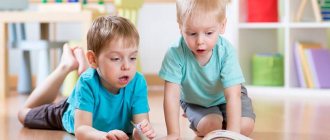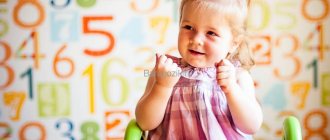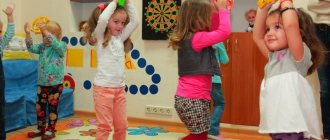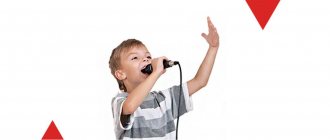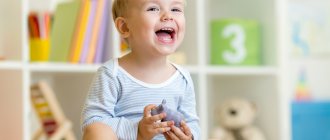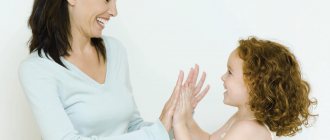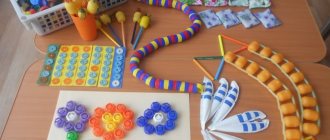Purity of speech affects future success at school and the process of social adaptation. Logorhythmics for children 2-3 years old is recognized throughout the world as a universal method for improving speech skills.
Logorhythmics is based on a set of exercises to improve articulation and breathing, physical fitness, and sense of rhythm. As a result of classes, both the ability to navigate the huge world around us and the understanding of the meaning and order of completing the proposed tasks increase. The little person begins to show himself as a creative person.
What it is
In preschool educational institutions, logorhythmics for toddlers and children 2-3 years old is used as one of the means of correctional pedagogy. An integrated technique, the name of which consists of two words – speech therapy and rhythmics, is necessary to improve speech, develop musical ear and coordination.
The method is successfully used by Russian specialists in correctional pedagogy; Ekaterina Zheleznova played a special role in its popularization. A full range of classes using different types of games and training includes:
- walking with a change of direction;
- breathing exercises;
- gymnastics that improves muscle tone;
- articulation of poetry;
- singing.
At each lesson, the child encounters music, words and movement, regular training accustoms him to a routine, they have a beneficial effect on the formation of the musculoskeletal, speech and other systems of the body.
Progress of the lesson:
Speech therapist : (there is a knock)
-I’ll see who’s knocking on our door now. Shows a doll .
-Who is this?
Children: doll .
Doll : My name is Tanya .
Speech therapist : Invites the children to shake hands with Tanya and say their name.
Speech therapist : Doll Tanya loves to play
- Do you love it?
Children:…
Speech therapist : now, the Tanya doll will perform movements, and you will guess and name what the doll . I'm starting" (show)
4. Listening. Game moment “Wake up Tanya”
.
(Lullaby “Bayubayu”
music
M. Kraseva, lyrics. M. Charnoy “Oh, you canopy”
b. n. P)
Tasks: teach, listen carefully to a lullaby and song; react emotionally to the affectionate, melodious and playful nature of the music; understand the content; actively participate in the game action.
What kids can't do without logorhythmics?
Parents are not always ready to admit the need for correctional pedagogy for their heirs; they develop at different speeds, and what is available to one at 2 years old, the second will master at 3. Individuality predetermines the education system. But in child development up to 2-3 years, logorhythmics will be inevitable if the baby:
- stutters;
- cannot cope with a normal speech rate;
- has dysarthria or has been diagnosed with mental retardation;
- poorly oriented in space;
- does not learn motor skills very quickly.
Note! Regular music and singing lessons, games, movement will quickly solve problems with a temporary slowdown in understanding the world around you and feeling yourself in it, tighten up and improve physical fitness
What is logorhythmics?
Logorhythmics is a method of active correctional pedagogy, the action of which occurs due to the combination of three elements - movement, music and speech (word/sound).
Is this method right for you?
Of course, correctional classes are designed for children with certain problems. Logorhythmics is suitable for children who have encountered difficulties such as:
1. Delayed speech development
2. Problems with articulation, pronunciation and speech rate
3. Poor coordination of movements, insufficient development of fine and gross motor skills
4. Stuttering
These are the main indications for practicing speech therapy rhythms. Of course, logorhythmics has not only medical indications, although it is designed to solve the above problems, it is an excellent pedagogical way for the learning and all-round development of a child.
It is possible that many mothers unknowingly use some techniques at home, thereby not only diversifying their child’s leisure time, but also providing a full-fledged lesson.
Logorhythmics for children 2-3 years old
At an early stage of development, the educational institution will take over the organization of training. The game form and the company of other students helping each other will accelerate the acquisition of speech skills. But parents should not completely shift responsibility to teachers, so as not to lose momentum and consolidate the achieved results. Games and exercises will not take much time and will bring joy to the whole family. The system is designed to achieve such goals as:
- training of speech skills or their correction;
- improvement of the body;
- breathing development;
- improving coordination;
- aesthetic education;
- improved sense of rhythm.
In home exercises, a set of basic exercises will be easy for the family, games and tongue twisters are easy to learn and repeat. The two most popular lesson series are based on familiar images of plants and animals, they will increase engagement in the process and make each lesson not only useful, but also entertaining.
At home, you can choose the time and songs and poems you like best, and tune in to your baby’s internal rhythms. For older people, breathing exercises and finger exercises are added. Classes should be held 2 times a week, closer to the evening. Parents will have to take time to prepare.
Vegetables and fruits
Fauna and flora are traditionally used in teaching. Exercises and rules for how to work with a child are offered in manuals and video lessons. They are based on imitation of actions that occur in the process of interaction with plants that come from the garden.
The baby, following his parents, repeats poems and performs steps, gestures, squats, and dance elements. Various tasks are offered. For example, during “pickling cabbage,” the baby reads the text and performs movements that imitate picking and chopping a head of cabbage, rubbing carrots, mixing and salting.
When traveling to a garden or farm, visual images of the gifts of nature are used, the teacher talks about how fruits, berries, and root vegetables grow. Next, the parent or teacher repeats movements imitating picking fruit. It is allowed to hide similar toys in the room. Each action is accompanied by an articulate pronunciation of the text.
Animals
A journey into the world of fauna combines poetry and imitative movements. The guys dance, holding their hands on their belts, like beetles, pulling their hands up, stomping. Having met a bear, they begin to clubfoot and walk, swaying from one foot to the other. Imitating a hare, they begin to stretch out their ears or crouch.
Exercises are most effective in a group when children see each other's movements. But at home, parents can become a clear example by learning poems and movements in advance using video lessons. The complex is fast and energetic, well develops motor skills and the ability to navigate in space and interact in a group.
Classes
Zheleznova’s logorhythmics were specially developed for children 2-3 years old. It is presented in a playful way, which will help the child in the company of other peers to significantly accelerate the acquisition of speech skills.
More often, a kindergarten takes on the function of teaching children logarithmics, but parents should also get involved in the training in order to consolidate the achieved results at home. Special exercises and games carried out at home will not take much time and will bring positivity to the family.
Zheleznova’s logorhythmics helps achieve the following goals:
- correct and train speech skills;
- carry out a complete recovery of the child’s body;
- develop proper breathing;
- improve coordination;
- improve aesthetic education;
- improve your sense of rhythm.
Zheleznova’s logorhythmics for children 2-3 years old involves the use of music, which allows further development of phonetic hearing. Simple and understandable songs about a bus, a bear, a spider, are composed in such a way as to maximally work out each muscle responsible for articulation.
A classic lesson using the Zheleznova method should consist of the following steps:
- greetings;
- warm-up;
- games involving gestures and finger exercises;
- massage in the form of a game;
- gymnastics to music;
- logorhythmics;
- chanting and singing;
- fairy tales;
- parting.
On average, one lesson should last no more than 45 minutes, otherwise the child will get tired and will not complete the entire program.
Bus
This exercise must be performed on a ball.
Speech therapist says:
- Here we are sitting on the bus, and sitting, and sitting.
At this time, the children slowly sway from side to side on the ball.
- And we look out of the window, we all look!
Children raise their hands and close their fingers in the shape of a window, then look out of it, turning first one way or the other.
- We look back, we look forward, like this, like this.
Children make turns in one direction or the other, peering into the distance from under their palms.
- Well, the bus is not lucky, is it not lucky?
A shrug is performed.
- The wheels started spinning like this, like this, we rolled forward like this!
At this time, children perform circular movements with their arms in front of them.
- And the brushes rustle on the glass, whack-whack-whack, whack-whack-whack,
- All the droplets want to sweep away whack-whack-whack!
Swinging is performed with arms bent at the elbows, which imitate the work of windshield wipers.
- And it’s not just that we sit, turn the steering wheel and beep: beep-beep-beep, beep-beep-beep,
- We all hum loudly and loudly: beep-beep-beep!
- Let the bus shake us like this, like this,
- We are moving and moving forward just like that!
Everyone is actively jumping on balls.
Beanbag
- Rattle, rattle, musical toy.
- If you want, take two at once and rattle, rattle, rattle,
- If you want, take two at once and rattle, rattle, rattle.
- Hide the rattle behind your back, your ears will rest from the noise,
- Look at your neighbor and sit quietly,
- Look at your neighbor and sit quietly.
Watch
Speech therapist says:
We sit on a rug or pillow (on our knees). We move our fingers (“run”) from the knees to the top of the head.
- The mouse climbed for the first time
- See what time it is.
- Suddenly the clock said: “Bang!”
Children perform one clap above their heads.
- The mouse rolled head over heels.
Children put their hands on the floor.
- The mouse climbed in a second time
- See what time it is
- Suddenly the clock said: “Bom, bom!”
Children perform 2 claps.
- The mouse rolled head over heels.
- The mouse climbed for the third time
- See what time it is.
- Suddenly the clock said: “Bom, bom, bom!”
Children perform 3 claps.
- The mouse rolled head over heels.
Little frogs
- Four frogs are sitting together on a stump,
- They sit on a stump together and eat delicious worms:
- Yum-yum, yum-yum, yum-yum-yum-yum-yum-yum!
- Yum-yum, yum-yum, yum-yum-yum-yum-yum-yum!
- Suddenly one dived into a puddle, fell asleep in the warm water,
- And three frogs eat delicious worms:
- Om-Nom-nom…
- Suddenly one dived into a puddle, fell asleep in the warm water,
- And two frogs eat delicious worms:
- Om-Nom-nom…
- Suddenly he dived into a puddle and fell asleep in the warm water.
- The latter still sits and looks at the worms.
Warm-up
When pronouncing the words of the song, the child must repeat the movements indicated in it:
- We nod our heads,
- Let's shake our noses,
- And let's knock our teeth
- And let's be silent for a while.
- We'll roll our shoulders
- And let's not forget about the pens,
- Let's shake our fingers
- And let's rest a little.
- We'll kick our feet
- And let's squat a little
- Let's match a leg with a leg
- And let's start all over again...
Our pens
Speech therapist says:
- Our hands are dirty, let's wash them with warm water.
- We wash our hands like this, like this.
Children imitate hand washing.
The speech therapist continues:
- We raise our hands, like this, like this.
- We raise our hands up, fingers spread out, and turn the “lanterns” over.
- We lower our arms like this, like this.
- We lower our hands, fingers spread, and turn the “lanterns” over.
- And we put it behind our back like this, like this.
Children put their hands behind their backs.
I want to build a house
- I want to build a house
- So that there is a window in it,
- So that the house has a door,
- Nearby for a pine tree to grow.
- So that there is a fence around
- The dog guarded the gate,
- So that a bug lives on the grass,
- He ran fast p-u-check.
- I want to build a house
- So that there is a window in it,
- So that the house has a door,
- Nearby for a pine tree to grow.
- It was sunny, it was raining,
- So that the tulip blooms in the garden,
- So that there is a flag on the house,
- And behind the house there lived a hedgehog.
Bunny
- The bunny jumped, jumped, jumped, jumped and got tired.
Children are jumping.
- He wiggled his tail.
Children drive the body.
- He raised his ears up.
Lesson on logorhythmics (Zheleznova system for children 2-3 years old).
Exercise - “Bunny” Children use their hands to depict bunny ears above their heads.
- The bunny jumped, jumped, jumped, jumped and got tired.
Children are jumping.
- He wiggled his tail.
Children drive the body.
- He raised his ears up.
Children use their hands to depict bunny ears above their heads.
- And the bunny heard a quiet, very quiet sound.
Children put their hand to their right ear and turn to the right, as well as to the left.
- I looked around.
Children make a “visor” over their eyes with their hands, turn to the right and also to the left.
- He suddenly jumped into the hole.
Children bounce in place or jump forward.
In giraffes
Before the game, the speech therapist asks the child to talk about what a giraffe, elephant, zebra, and cat look like.
You need to show them pictures of these animals, noting their characteristic external features:
- the giraffe has spots;
- the elephant has folds;
- the kitten has fur;
- The zebra has stripes.
Next, the speech therapist reinforces the words with gestures that will be used in the game:
- Giraffes have spots, we clap our hands all over the body.
- Elephants have folds, we “collect the folds”, we pinch ourselves.
- Kittens have fur, let's stroke ourselves.
- And the zebra has stripes, we run our fingers or the edge of our palm along the body.
During the chorus, children point with their index fingers at the named body parts.
Together with us
- You clap with us: clap and clap.
- You clap with us: clap and clap.
- You clap with us, you clap with us.
- You clap with us: clap and clap.
- You stomp along with us: stomp and stomp...
- You jump with us: jump and jump...
- And now you will dance with us,
- And now you will dance with us,
- And now you will be with us, and now you will be with us,
- And now you will dance with us.
To get real, lasting and quick results, you should follow several important rules:
| Rules | Peculiarities |
| Correct load formation | Select the load for the child according to his age. |
| Choose the right class time | The best time for classes is in the afternoon, after the child has had lunch and rested. |
| Change the topic of the lesson | Try to select different topics for classes every week, then it will be more interesting for the child. |
| Correctly selected material | When selecting, it is important to focus on lexical topics. |
| Diversify the material | Try to organize the lesson correctly, add scenes from fairy tales or cartoons to make it more interesting for the child to perform speech and musical exercises. |
| Regularity | You need to work with your child every day. |
| Show movements correctly | Try to show all the movements correctly, pronounce the words of the songs so that the child understands everything. |
Logorhythmics by Zheleznova is a unique author’s program that includes musical, speech and physical exercises. Children aged 2-3 years enjoy dancing, singing and imitating different sounds, improving their speech, improving motor function and becoming completely healthy.
It is very important to remember that results can only be achieved if logarithmics are performed regularly.
Logorhythmics by Ekaterina Zheleznova for children 2-3 years old
Music will become an essential part of training if you use a specially designed complex. The system of correctional pedagogy was developed by many domestic scientists, but Zheleznova’s logorhythmics for children 2-3 years old is especially popular among parents.
It includes musical accompaniment; it is necessary to use backing tracks; an additional result of using the technique will be the development of phonetic hearing. Simple songs about a bus, a bear, or a spider are constructed in such a way as to maximize the training of the muscles responsible for articulation.
The complex will be most useful for the age group up to four years old; at this stage of life, hearing and a penchant for music are well formed. Zheleznova’s speech therapy logorhythmics for children 2-3 years old will be a universal way to harmonize a child’s personality and help him grow spiritually, but it should not become the only method.
Additional training and games, such as “Postman” or “Wind and Trees,” will introduce the little person to the people and phenomena of the world around him. They also combine a complex of poems and movements.
Systematic use of logorhythmics, combination of activities with teachers and parents, monitoring and correction of results will quickly affect the development of the baby and the quality of his speech. The successes he achieves will bring joy to his parents, stimulating them to continue their studies.
Progress of the lesson:
Music director: “ Tanya is tired and wants to sleep. Tanya will sleep , and we will sing Tanya a lullaby."
Speech therapist : (rocks the doll )
.
Music of hands: (performs a song)
.
Next, he invites the children to clap their hands to wake up Tanya. Tanya doesn't wake up . We stomp our feet. Tanya wakes up .
Music director: “ Tanya is rested and wants to go for a walk, to cheerful music ( the doll is “dancing”
in the hands
of a speech therapist ).
5. Rhythmic game “Walking with a doll ”
Objectives: to teach children to distinguish between the rhythm of walking and running; to convey it by slapping the palms of the hands on the knees: slowly and quickly (first as shown by an adult , then by pronouncing words and performing movements.
